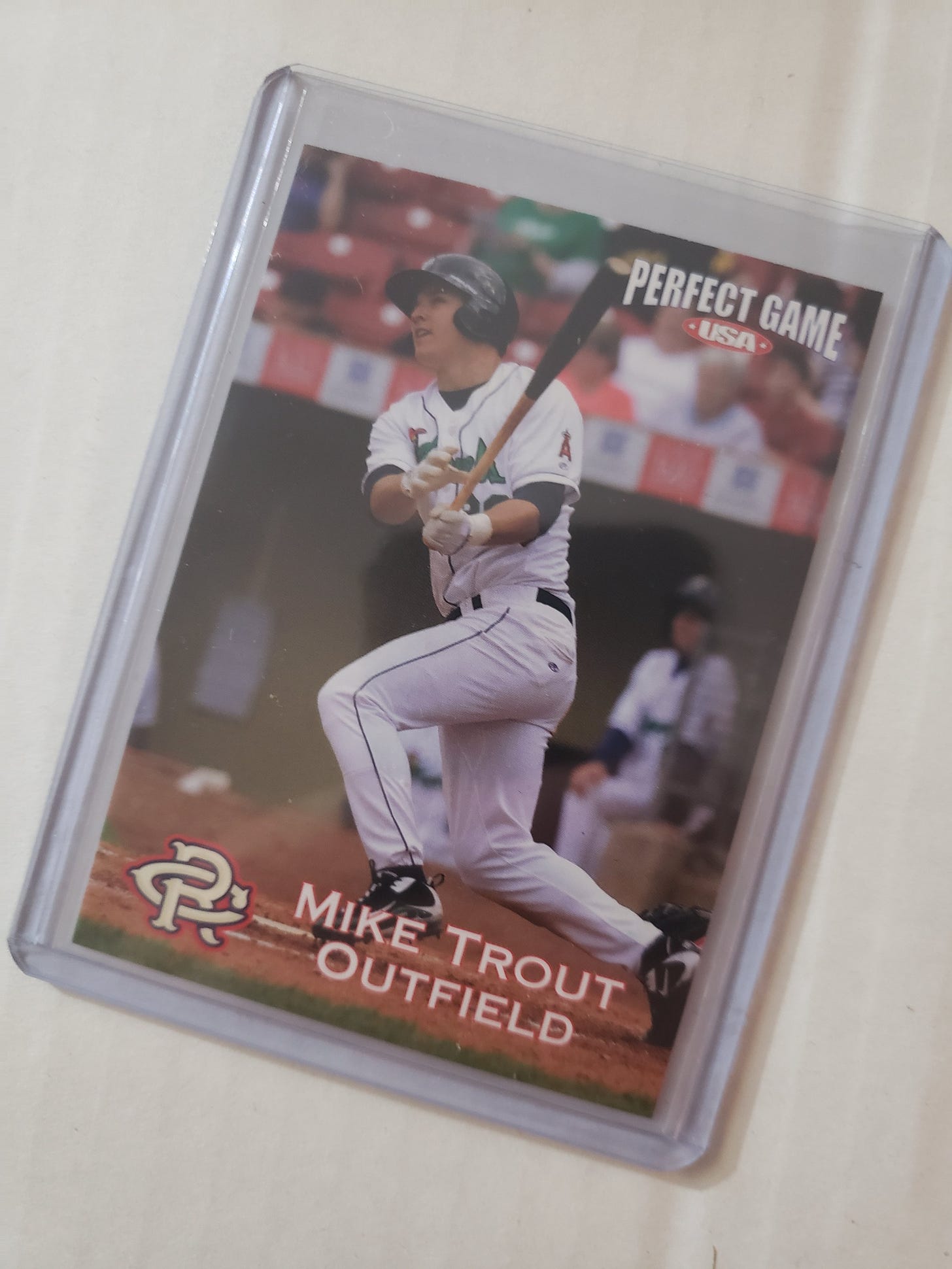Cardboard treasures might be closer than you realize
When you click on links to various merchants on this site and make a purchase, this can result in this site earning a commission. Affiliate programs and affiliations include, but are not limited to, the eBay Partner Network.
When you have been collecting cards for decades, you might not remember every card in your collection. They accumulate quickly.
During the recent stay-at-home orders, I’ve had a lot of time to think about my collection and what could potentially be in it. Other than the cards in my player PC, most of the cards from over the years have been put into boxes in a closet to create space.
Anyone with a toddler knows just how precious every spare inch is.
Since I’m notoriously a hoarder when it comes to cards — I don’t like selling or trading — I have to be really convinced to part with something. Which means, there could be a treasure trove in that closet – or a lot of junk wax.
So, one Saturday night, my husband and I went digging into the card closet (doesn’t everyone have a card closet?). There were rows and rows of long white boxes. The cards were put in there after being ripped from their wrappers to make room for more cards.
In this case, we were on the hunt for 2013-14 Prizm Giannis Antetokounmpo rookie cards, which generally sell for more than $500. When Prizm came out, I was working for Becket Media as the Basketball Editor. There was a good chance that I opened a box or two of Prizm that year.
So, we dug in.
Box after box was pulled from the closet. We found tons of cards from the ‘80s and ‘90s, reminding us the way cardboard felt from our childhoods. There were modern cards sorted by product — baseball, hockey, basketball, football and non-sports cards. While looking for 2013-14 Prizm Basketball, I ran into a row that had 2011 Topps Baseball Update cards, the set that features Mike Trout’s rookie card.
Things just got more interesting.
This row featured base cards and inserts from the now famed product. I went through the cards carefully to try and limit any potential damage.
I slipped one card to the side and there it was, Trout swinging for the fences — a card I didn’t realize I owned. Some may think this is crazy, but this is part of the reason why I have such a hard time getting rid of cards.
You never know what buried treasure you can find years later.
I carefully put it in a penny sleeve and top loader and added it to a different box that didn’t go back in the closet.
It actually makes sense I would have this card. Back in 2009 when Trout was drafted, I was a sports reporter for The Press of Atlantic City in New Jersey, which covered Trout’s hometown of Millville. I covered more of his basketball games than baseball games (and in fact, many of his baseball games his senior year of high school got rained out). I traveled to Cedar Rapids, Iowa during Trout’s first full minor league season in 2010 to write a feature article about him. While there, I picked up a Kernels team set that featured Trout’s first minor league baseball card.
The team set, with Trout’s card in front, was also in the closet. This I remembered buying.
I bought a number of Trout’s cards in 2010 and 2011. As a collector, that’s what I did to feel a connection to the game. I didn’t know that Mike Trout would become Mike Trout. Instead it was neat to see a young player from South Jersey drafted in the first round.
It was exciting to find these cards – and not just because of the value.
The price of wax is so high right now that I feel priced out. Unless it’s something I can find at retail (and retail is not an option with the current pandemic), I won’t be opening any wax.
This exploration felt similar to busting wax in that I wasn’t sure what I would find. But I was thrilled to rediscover these gems and have them in my collection. Going through the boxes led me to find other cards of players I enjoy collecting (although all the Derek Jeter cards have already been pulled out). I’m better at putting those cards in boxes that are more accessible.
I also found older sets that I put together including the 2001 Upper Deck Legends of New York and cards of Yankees I threw into boxes to sort through later.
It was a good reminder of the joy of collecting — cards can bring you pleasure years later. Putting cards in boxes or storing them in binders allows you to take a look at them from time to time. These picture cards have a way of bringing back moments or memories that are connected to the cards.
Just because the 1991 Fleer Kevin Maas card I found wasn’t worth $500 doesn’t mean I didn’t enjoy it any less. I was delighted in knowing I plucked this card from the darkness and gave it light again.
Oh, and those Giannis Antetokounmpo cards. We found two of them.
Pieces of flair, the bare minimum, and 2020 Topps
By Dan Good
"Let me ask you a question, Joanna. What do you think of a person who only does the bare minimum?” — Stan, “Office Space”
More than 20 years after Joanna (Jennifer Aniston) had enough of her boss Stan (Mike Judge) and quit working at the restaurant Chotchkie's in the movie “Office Space,” their conversation about the bare minimum and pieces of flair still resonates.
Especially in terms of Topps’ handling of my favorite team.
If you remember, Topps Baseball Series 1 contained only one Rangers base card — Nick Solak. Topps addressed the slight during the Million Card Rip Party in February, held in the forgotten team’s home city.


This is not the first time Topps has used a commemorative logo on a base card … but getting past that point, the implication was that Topps was purposefully holding back Rangers cards for Series 2, which I don’t buy.
For one, this type of situation hasn’t happened before. This is a product that previously included variations in anticipation of a team potentially moving to a new city (in the end, the Padres stayed put).
Additionally, If the holdup was with the logo or uniform, MLB would have flagged and removed all Rangers cards in Series 1, including Solak. The stadium logos weren’t necessary — they weren’t included in the Rangers team set versions of Series 1 and Series 2 cards — they’re an added “bonus.”
To make sense of the situation, it helps to understand the process behind Topps checklists (I happen to know someone who knows a bit about this). For products like flagship, you’d start filling out the checklist with rookies that need to be included such as Solak. From there you’d add newly signed players and other veterans, ensuring that each team is adequately represented.
That's what was missed in this case. After Solak was included the Rangers were ignored, and no one caught the mistake until it was too late to fix it.
We get to our “Office Space” moment with last week’s release of Series 2. The “pieces of flair” — a logo on the front of Rangers cards celebrating a stadium that looks from the outside like a nondescript shipping depo — are meh. I was hoping they would compare to the foil-stamped factory set cards honoring the expansion teams — Rockies and Marlins in 1993, Devil Rays and Diamondbacks in 1998. But the stadium logo doesn’t add much, and in some cases, when paired with the Rookie Card logo, Topps logo and Rangers logo, can make the card fronts look like a sponsorship-littered soccer jersey. In fact, the most exciting Rangers card fronts, Elvis Andrus’ and Brock Burke’s short print photo variations, don’t include the stadium logo.
And then there’s the bare minimum. Series 2 features 18 Rangers cards in its base set — 16 players and two team cards. When adding those 16 player cards to Solak’s from Series 1, it gives us 17 cards, the exact number needed for the individually packaged team sets.
So Topps, after ignoring the Rangers in Series 1, produced for Series 2 only the number of additional cards needed, meaning Texas still comes up short behind every other team for this year’s Topps base set. Other teams have roughly 20-25 cards, a number of which were excluded from the 17-card team sets.
I get it. My team isn’t very exciting right now.
But the situation is indicative of a larger problem for collectors of teams like the Rangers, Diamondbacks, Marlins or Rays: as far as Topps is concerned, they largely don’t matter. Using Beckett’s database, I recently crunched the numbers on all Topps cards produced from 2016 to 2020 by team.
The top five teams:
Yankees: 39,736
Red Sox: 32,793
Cubs: 30,433
Astros: 27,772
Dodgers: 26,465
The bottom five teams:
Tigers: 13,921
Rangers: 13,870
Diamondbacks: 13,243
Marlins: 12,415
Rays: 12,207
Those trends are also reflected in Project 2020, the hot digital product featuring artistic takes on some of Topps' iconic cards. Only 14 teams are featured, and none of the “bottom five” teams (the “top five” teams make up six of the 20 cards, including Don Mattingly, Mariano Rivera and Derek Jeter for the Yankees). The only Rangers inclusion I’ve found comes on Ryan Thiele's reimagined 1969 Nolan Ryan Mets card that shows, over the pitcher’s shoulder, a depiction of his famous 1993 fight with White Sox third baseman Robin Ventura.
It’s a nice easter egg, a piece of Rangers flair, but there haven’t been enough of them on Topps cards lately. As a collector and fan, I’m tired of seeing the bare minimum, year after year and product after product, so this is me, expressing myself.
Trading Card News Round Up
2020 Prizm Blockchain Set to Launch on Monday (Panini America)
McCutchen’s Swaggerfic Series 2 Card Generates Buzz (Sports Collector Daily)
An Expansive Look at Expansion on Baseball Cards (Night Owl Cards)
Big League Will Save Us (Baseball Dime Box)
Topps Project 2020: How Pop Art Changed Sports Cards (Den of Geek)




